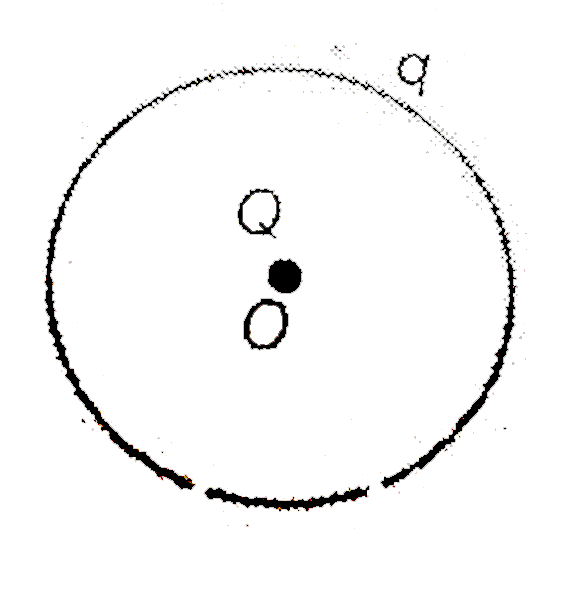Charge q2 is at the centre of a circular path with radius r. work done in carrying charge q1 once around this equipotential path , would be
14πε0×q1q2r2
14πε0×q1q2r
zero
Infinity
The correct Answer is:C
To solve the problem of finding the work done in carrying charge q1 once around a circular path of radius r with charge q2 at the center, we can follow these steps:
1. Understanding the Setup:
- We have a charge q2 located at the center of a circular path with radius r.
- We are moving another charge q1 around this circular path.
2. Identifying the Nature of the Path:
- The circular path around the charge q2 is an equipotential surface. This means that the electric potential at every point on this path is the same.
3. Work Done in Electric Fields:
- The work done W in moving a charge in an electric field is given by the formula:
W=q⋅V
where V is the potential difference.
4. Potential Difference on the Equipotential Surface:
- Since the circular path is an equipotential surface, the potential difference V when moving charge q1 around the path is zero:
V=0
5. Calculating the Work Done:
- Substituting the potential difference into the work done equation:
W=q1⋅0=0
6. Conclusion:
- Therefore, the work done in carrying charge q1 once around the equipotential path is:
W=0
Final Answer:
The work done in carrying charge q1 once around the equipotential path is 0.
---
- We have a charge q2 located at the center of a circular path with radius r.
- We are moving another charge q1 around this circular path.
- The circular path around the charge q2 is an equipotential surface. This means that the electric potential at every point on this path is the same.
- The work done W in moving a charge in an electric field is given by the formula:
W=q⋅V
where V is the potential difference.
- Since the circular path is an equipotential surface, the potential difference V when moving charge q1 around the path is zero:
V=0
- Substituting the potential difference into the work done equation:
W=q1⋅0=0
- Therefore, the work done in carrying charge q1 once around the equipotential path is:
W=0
The work done in carrying charge q1 once around the equipotential path is 0.
Topper's Solved these Questions
- ELECTROSTATIC POTENTIAL AND CAPACITANCE BOOK - AAKASH INSTITUTECHAPTER - ELECTROSTATIC POTENTIAL AND CAPACITANCE EXERCISE - ASSIGNMENT SECTION - D
13 Videos
- ELECTROSTATIC POTENTIAL AND CAPACITANCE BOOK - AAKASH INSTITUTECHAPTER - ELECTROSTATIC POTENTIAL AND CAPACITANCE EXERCISE - ASSIGNMENT SECTION - B
38 Videos
- ELECTROMAGNETIC WAVESBOOK - AAKASH INSTITUTECHAPTER - ELECTROMAGNETIC WAVESEXERCISE - ASSIGNMENT SECTION - D Assertion-Reason Type Questions
25 Videos
- GRAVITATION BOOK - AAKASH INSTITUTECHAPTER - GRAVITATION EXERCISE - ASSIGNMENT SECTION - D (ASSERTION-REASON TYPE QUESTIONS)
16 Videos
Similar Questions
A charge +Q is lying at the center of a circle. What is work done in carrying charge q from A to B, where A and B, both lie on the circle.
View SolutionA point charge Q is placed at the centre of a circular wire of radius R having charge q. Find the force of electrostatic interaction between point charge and the wire.

View Solution
Knowledge Check
The work done in carrying a charge Q1 once round a circle of radius R with a charge Q2 at the centre is
A14πε0×q1q2r2B14πε0×q1q2rCzeroDInfiniteWork done in moving a positive charge on an equipotential surafce is
Afinite, Positive but not zeroBfinite, negative but not zeroCzeroDinfiniteThe work done in moving a positive charge on an equipotential surface is
Afinite and positiveBinfiniteCfinite and negativeDzero
The work done in carrying a charge q once round a circle of radius r with a charge Q at the centre is
View SolutionThere is 10 units of charge at the centre of a circle of radius 10m. The work done in moving 1 unit of charge around the circle once is
View SolutionThe magnetic momenrt of a circular orbit of radius 'r' carrying a charge 'q' and rotating with velocity v is given by .
View SolutionA charge moves with a speed v in a circular path of radius r around a long uniformly charged conductor.
View SolutionWork done in moving a positive charge on an equipotential surafce is
View Solution
